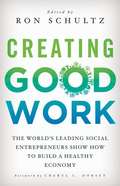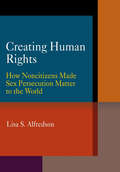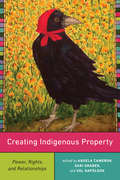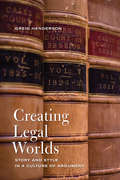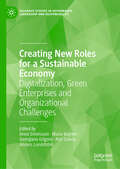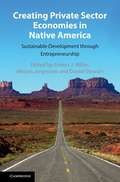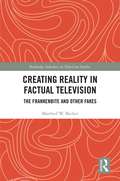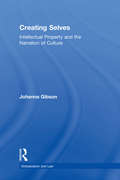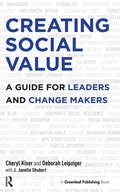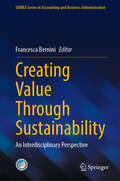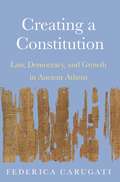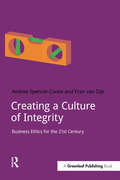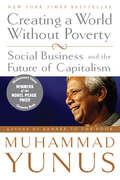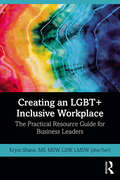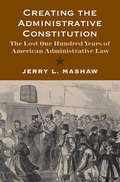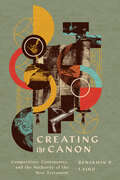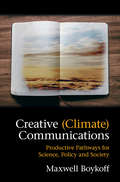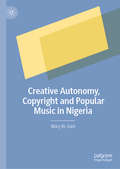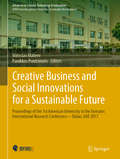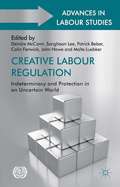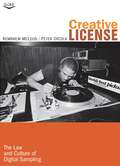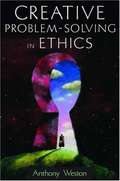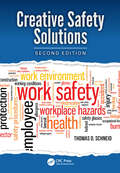- Table View
- List View
Creating Good Work: The World's Leading Social Entrepreneurs Show How to Build a Healthy Economy
by Ron Schultz Cheryl L. DorseyWhile social entrepreneurship continues to grow by leaps and bounds over the last decade, practitioners have begun to realize that no one model can be used for every type of social venture. Be it a start-up for enhancing the educational opportunities a community has access to or a program to address the sustainability of a region's environment, each type of social venture comes with its own hardships and pitfalls on its path to creating a better tomorrow. Creating Good Work is a practical resource that goes beyond storytelling. It is a rich guide book recounts the stories of some of the most successful social entrepreneurial programs operating today, with real life examples of and how they overcame both physical and societal barriers to create a lasting impact on the world they encounter. Including contributions from leading names at such social ventures as Benetech, Brac-USA, KivaRoot Capital, Skoll Foundation, 7th Generation, and YouthBuild, many of whom have been recognized by organizations like the Skoll Foundation and Ashoka: Innovators for the Public as being among the world's best. The lessons these leaders share contained in this volume are an asset to any social entrepreneur looking for new and innovative ways to have a positive impact on change the world around them, be they at their initial concept phase or a successful venture looking to expand their sphere of influence.
Creating Human Rights
by Lisa S. AlfredsonSelected by Choice magazine as an Outstanding Academic Title for 2009Creating Human Rights offers the first systematic study of a pioneering women's refugee movement and its challenge, as an international trigger case, to more conventional paths toward human rights policy development. Lisa S. Alfredson argues that such cases, which unfold in the context of a specific country and have profound impacts on international human rights efforts, have been neglected in research and pose a challenge to recent theorizing on human rights change.In the early 1990s, Canada witnessed the emergence of the world's first comprehensive refugee policy for women who were seeking protection from female-specific forms of violence--rape, domestic abuse, public stoning of adulterers, genital mutilation--while challenging a gender-biased system. Close examination of this novel movement, Alfredson contends, provides crucial insights into why and how states may articulate new human rights that set international precedents.Analyzing original empirical data and sociopolitical historical trends, the book documents the decisive global impacts of the movement while shedding light on the paradox of noncitizen politics and asylum seekers' little recognized political strength. Contrary to expectation, findings suggest transnational networks and pressures are not required for some forms of change. Rather, international trigger cases illuminate a range of other key actors and advocacy strategies leading, subsequently, to a more comprehensive understanding of human rights acceptance.In the case of the women's refugee movement, the convergence of human rights and noncitizen politics points toward a new dimension for human rights scholarship that, in the current age of globalization, is becoming critically important.
Creating Indigenous Property: Power, Rights, and Relationships
by Angela Cameron Sari Graben Val NapoleonWhile colonial imposition of the Canadian legal order has undermined Indigenous law, creating gaps and sometimes distortions, Indigenous peoples have taken up the challenge of rebuilding their laws, governance, and economies. Indigenous conceptions of land and property are central to this project. Creating Indigenous Property identifies how contemporary Indigenous conceptions of property are rooted in and informed by their societally specific norms, meanings, and ethics. Through detailed analysis, the authors illustrate that unexamined and unresolved contradictions between the historic and the present have created powerful competing versions of Indigenous law, legal authorities, and practices that reverberate through Indigenous communities. They have identified the contradictions and conflicts within Indigenous communities about relationships to land and non-human life forms, about responsibilities to one another, about environmental decisions, and about wealth distribution. Creating Indigenous Property contributes to identifying the way that Indigenous discourses, processes, and institutions can empower the use of Indigenous law. The book explores different questions generated by these dynamics, including: Where is the public/private divide in Indigenous and Canadian law, and why should it matter? How do land and property shape local economies? Whose voices are heard in debates over property and why are certain voices missing? How does gender matter to the conceptualization of property and the Indigenous legal imagination? What is the role and promise of Indigenous law in negotiating new relationships between Indigenous peoples and Canada? In grappling with these questions, readers will join the authors in exploring the conditions under which Canadian and Indigenous legal orders can productively co-exist.
Creating Legal Worlds
by Greig HendersonA legal judgment is first and foremost a story, a narrative of facts about the parties to the case. Creating Legal Worlds is a study of how that narrative operates, and how rhetoric, story, and style function as integral elements of any legal argument.Through careful analyses of notable cases from Canada, the United States, and the United Kingdom, Greig Henderson analyses how the rhetoric of storytelling often carries as much argumentative weight within a judgement as the logic of legal distinctions. Through their narrative choices, Henderson argues, judges create a normative universe - the world of right and wrong within which they make their judgements - and fashion their own judicial self-images. Drawing on the work of the law and literature movement, Creating Legal Worlds is a convincing argument for paying close attention to the role of story and style in the creation of judicial decisions.
Creating New Roles for a Sustainable Economy: Digitalization, Green Enterprises and Organizational Challenges (Palgrave Studies in Governance, Leadership and Responsibility)
by Anders Lundström Georgiana Grigore Alin Stancu Anna Sörensson Maria BogrenCommitment to sustainability and social responsibility goals will require the creation of new roles and entrepreneurial approaches. This contributed volume addresses the emerging roles of businesses, markets, approaches, and practices for a sustainable economy and asks the following questions: What new roles are existing businesses adopting in their practices in social responsibility and sustainability? How does the integration of sustainability and corporate social responsibility strategies and practices change the ways in which organizations operate? What types of markets are emerging for sustainable businesses? What is the role of social enterprises and non-profit organizations in shaping new roles and markets for a sustainable economy? The volume is divided in three thematic sections. The first explores digitalization, green businesses and sustainable. The second considers the new roles for sustainability and their importance for SMEs and social entrepreneurship. Finally, the book ends with a reflection on the key organizational challenges for sustainable development, including how these might be addressed by academics and practitioners. This book will be relevant to students and scholars of organisation studies, corporate social responsibility, social entrepreneurship and digital business. Relevant to the pursuit of the UN Sustainable Development Goals, it will be of broader interest to anyone with an interest in sustainable development and the future of work.
Creating Private Sector Economies in Native America: Sustainable Development through Entrepreneurship
by Miriam Jorgensen Robert J. Miller Daniel StewartNative nation economies have long been dominated by public sector activities - government programs and services and tribal government-owned businesses - which do not generate the same long-term benefits for local communities that the private sector does. In this work, editors Robert Miller, Miriam Jorgensen, Daniel Stewart, and a roster of expert authors address the underdevelopment of the private sector on American Indian reservations, with the goal of sustaining and growing Native nation communities, so that Indian Country can thrive on its own terms. Chapter authors provide the language and arguments to make the case to tribal politicians, Native communities, and allies about the importance of private sector development and entrepreneurship in Indigenous economies. This book identifies and addresses key barriers to expanding the sector, provides policy guidance, and describes several successful business models - thus offering students, practitioners, and policymakers the information they need to make change.
Creating Reality in Factual Television: The Frankenbite and Other Fakes (Routledge Advances in Television Studies)
by Manfred W. BeckerCreating Reality in Factual Television analyzes the uneasy interaction between economics, culture, and professional ethics in reality and documentary television storytelling. Through the "frankenbite," an editorial tool that extracts and re-orders the salient elements or single words of a statement, interview, or exchange into a revealing confession or argument, the book explores how and why editors manipulate truth in factual television. The author considers how the editing of documentary television is increasingly following reality television’s dictate to entertain instead of inform, how the "real" and the "truth" fall victim to the demand to "tell entertaining stories," and how editors must compromise their professional ethics as a result. Drawing on interviews with 75 North American and European editors that explore their experiences and opinions of reality and documentary television practices, and their views on their responsibilities and loyalties in the field, Creating Reality in Factual Television illuminates the real and potential ethical dilemmas of editorial decision making, the context in which decisions are made, and how editors themselves validate the editing choices to themselves and others. Addressing a dramatic development in contemporary media ecology – the age of "alternative facts" – this book is a useful research tool for scholars and students of documentary film, media literacy, genre studies, media ethics, affect theory, and audience perception.
Creating Selves: Intellectual Property and the Narration of Culture (Globalization and Law)
by Johanna GibsonThe concept of creativity, together with concerns over access to creativity and knowledge, are currently the subject of international debate and unprecedented public attention, particularly in the context of international developments in intellectual property laws. Not only are there significant developments at the legal level, with increasing moves towards stronger and harmonized protection for intellectual property, but also there is intense public interest in the concepts of creativity, authorship, personality, and knowledge. In Creating Selves, Johanna Gibson addresses strategic responses to intellectual property, and suggests alternative models for encouraging, rewarding, and disseminating creative and innovative output, which are built upon a critical analysis of and approach to the debate and to the concept of creativity itself. Drawing upon critical theories in authorship, literature, music, the sciences and the arts, Gibson suggests a radical re-consideration of the notion of creativity in the intellectual property debate and the means by which to encourage and sustain creativity in contemporary society.
Creating Social Value: A Guide for Leaders and Change Makers
by J. Janelle Shubert Deborah Leipziger Cheryl KiserThere is a new business landscape, where companies are increasingly being judged on their ability to generate _social value_. But there is no off-the-shelf solution for the leaders and change makers in this new domain. Creating social value is a journey, and each company must chart its own path through uncertain and complex terrain. We invite you to discover how the entrepreneurial leaders profiled in this book have become trailblazers, using strategy and innovation to generate profits and social value simultaneously.Creating Social Value provides insights into the motivations and preoccupations of groundbreaking entrepreneurial leaders as they look to activate change not just within their companies, but also in their sectors, value chains and even through co-creating partnerships with their competitors. Such change requires fundamentally new styles of leadership and business design where companies seek to be generative rather than extractive.This book also bears witness to the emergence of new language to describe these innovative concepts. Working with and sharing ideas with social entrepreneurs and entrepreneurs inside, the authors became aware of the building blocks of a new lexicon with the power to inspire and positively influence the culture of an organization. Many of the leaders included in this book have driven change by harnessing the power of language to reroute their company’s direction.For example, The Campbell Soup Company has created _destination goals_ to describe the long-term vision of the company to nourish its customers, employees and neighbours. Roshan has worked on _nation building_, creating physical infrastructure in Afghanistan, a country decimated by war. UPS has worked to understand its impact on the planet, building a _materiality matrix_ of the issues that matter to its stakeholders, while working to create a culture that fosters social innovation and seeks to understand _constructive dissatisfaction_. Ford is redefining its mission, imagining a different future in which it provides _mobility solutions_, rather than only manufacturing cars. Ford is working with Toyota to co-create technologies to combat climate change.This book sets out a manifesto for Social Value Creation, which is defined as a strategy that combines a unique set of corporate assets (including innovation capacities, marketing skills, managerial acumen, employee engagement, scale) in collaboration with the assets of other sectors and firms to co-create breakthrough solutions to complex economic, social and environmental issues that impact the sustainability of both business and society. Social innovation differs from corporate responsibility in two significant ways: it is strategic and it leverages a wide range of corporate assets and core competencies.Creating Social Value has been designed as a manual for change. It will be essential reading for business students, entrepreneurs and all of those wishing to effect positive, generative change in larger organizations.
Creating Value Through Sustainability: An Interdisciplinary Perspective (SIDREA Series in Accounting and Business Administration)
by Francesca BerniniAdopting a multidisciplinary approach, this book examines the interaction between ESG strategies and value creation. It highlights how sustainability is a wide-ranging concept capable of engaging the social sciences in various ways. Firstly, the study analyses how ESG initiatives can enhance value creation using a framework inspired by strategic cost management. Then, it takes an ethical perspective by investigating the ethics-washing phenomenon associated with the (ir)responsible use of artificial intelligence. Furthermore, the focus is on the integration of ESG factors into risk management and performance measurement systems through the lens of management accounting, and on the interplay between corporate social responsibility and tax avoidance. Moreover, the book proposes a constitutionally oriented reading of corporate sustainability from a legal standpoint. It also includes the perspective of financial companies, exploring the role of administrative controls in fostering banks' commitment to sustainability. The study focuses also on an organizational perspective by exploring how human resource management can support ESG strategies. Finally, the research underlines the corporate model “Società Benefit” to examine its effect on default risk.
Creating a Constitution: Law, Democracy, and Growth in Ancient Athens
by Federica CarugatiA comprehensive account of how the Athenian constitution was created—with lessons for contemporary constitution-buildingWe live in an era of constitution-making. More than half of the world's constitutions have been drafted in the past half-century. Yet, one question still eludes theorists and practitioners alike: how do stable, growth-enhancing constitutional structures emerge and endure? In Creating a Constitution, Federica Carugati argues that ancient Athens offers a unique laboratory for exploring this question. Because the city-state was reasonably well-documented, smaller than most modern nations, and simpler in its institutional makeup, the case of Athens reveals key factors of successful constitution-making that are hard to flesh out in more complex settings.Carugati demonstrates that the institutional changes Athens undertook in the late fifth century BCE, after a period of war and internal strife, amounted to a de facto constitution. The constitution restored stability and allowed the democracy to flourish anew. The analysis of Athens's case reveals the importance of three factors for creating a successful constitution: first, a consensus on a set of shared values capable of commanding long-term support; second, a self-enforcing institutional structure that reflects those values; and, third, regulatory mechanisms for policymaking that enable tradeoffs of inclusion to foster growth without jeopardizing stability.Uniquely combining institutional analysis, political economy, and history, Creating a Constitution is a compelling account of how political and economic goals that we normally associate with Western developed countries were once achieved through different institutional arrangements.
Creating a Culture of Integrity: Business Ethics for the 21st Century (Doshorts Ser.)
by Andrea Spencer-Cooke Fran van DijkFor companies, unethical business practices like bribery and corruption pose major business risks, and can result in fines, reputational damage, lost business opportunity and – increasingly – criminal or civil charges.Organizations have responded to this critical governance issue with rigorous formal integrity and compliance frameworks, to set out and enforce standards for ethical business practice. But companies also need to create an enduring culture of integrity that establishes doing the right thing as the cultural norm across the organization – and this requires more than compliance alone.Creating a Culture of Integrity identifies the key actions sustainability and compliance officers can take to foster this cultural shift within their organizations.This "one-stop" toolkit for embedding integrity also includes: inspiring best-practice case studies from companies who’ve implemented culture change, with insights on how they deal with ethical dilemmas when these arise and; powerful arguments to help you make the business case for building a strong ethical culture around your compliance system.
Creating a Sustainable Brand: A Guide to Growing the Sustainability Top Line (Doshorts Ser.)
by Henk CampherSustainable brands may have started as "doing less harm" and shaving costs off the bottom line. But brands today, supported by over a decade of phenomenal changes in sustainability, are looking for the holy grail of sustainable business – a fusion of products and branding that can actually drive sustainability and grow the business top line.Consumers have already joined the party. Just look at TOMS, Patagonia, Method, Seventh Generation, Dove and many more. What is missing isn’t the consumer but a better understanding of what fully-rounded consumers really want in their quest for a healthy, fulfilling life.This guide by sustainable brand expert Henk Campher is the model for creating a sustainable brand that people can trust, buy and above all, advocate for. Campher cuts through the myths and noise to offer an experienced expert's 101 for creating an irresistible brand, clearly setting out: what makes a product or service sustainable; the basic elements of sustainable branding strategy and a deep understanding of how consumers connect with a brand; an original model for assessing the sustainability of your brand, and; a host of examples of sustainable brands, drawing on the author's firsthand experience as part of the team at Edelman and Oxfam and founder of the Nelson Mandela initiated Proudly South African campaign.
Creating a World Without Poverty: Social Business and the Future of Capitalism
by Muhammad YunusIn this newly updated national bestseller, Nobel Peace Prize?winner Muhammad Yunus outlines his vision of a new business model that combines the power of free markets with the quest for a more humane world.
Creating an LGBT+ Inclusive Workplace: The Practical Resource Guide for Business Leaders
by Kryss ShaneSetting out best practices and professional guidance for creating LGBT+ inclusive workplaces, this approachable and easy to follow book guides current and future leaders of all industries toward appropriate and proven ways to create safer working environments, update company policies, enhance continuing education and training, and better support LGBT+ people in the workplace. Featuring real-life situations and scenarios, a glossary, and further resources, Creating an LGBT+ Inclusive Workplace enables professionals in all aspects of professional roles to integrate foundational concepts into their everyday interactions with staff at all levels as well as within the community to create an overall workplace culture that nurtures a welcoming, inclusive, and affirming environment for all. This book includes postcards from PostSecret as its foreword and more than a dozen exclusive interviews from the world’s top leaders in a variety of industries with world-renowned reputations. Enabling professionals in a variety of business roles to create an overall workplace culture that nurtures a welcoming, inclusive, and affirming environment for all, this book is an essential resource for independent readers, department teams, and entire corporations.
Creating the Administrative Constitution
by Jerry L. MashawThis groundbreaking book is the first to look at administration and administrative law in the earliest days of the American republic. Jerry Mashaw demonstrates that from the very beginning Congress delegated vast discretion to administrative officials and armed them with extrajudicial adjudicatory, rulemaking, and enforcement authority. The legislative and administrative practices of the U. S. Constitution’s first century created an administrative constitution hardly hinted at in its formal text. This book, in the author’s words, will "demonstrate that there has been no precipitous fall from a historical position of separation-of-powers grace to a position of compromise; there is not a new administrative constitution whose legitimacy should be understood as not only contestable but deeply problematic. "
Creating the Canon: Composition, Controversy, and the Authority of the New Testament
by Benjamin P. LairdDespite the profound influence of the New Testament, a variety of questions related to its background and history remain common. Contemporary readers often find the subject of the canon’s origin and formation to be complicated and confusing, while scholars continue to struggle to find agreement about basic elements of the canon’s development. In this engaging study, Benjamin P. Laird explores several misunderstood, disputed, and overlooked topics in order to provide fresh insight and clarity about the canon’s creation and modern relevance. The volume addresses questions such as: Was there a single “original autograph” of each New Testament writing? Who exactly were the “original readers” of the New Testament writings? Did theological controversies play a decisive role in prompting the canon’s formation? How did such a diverse body of writings come together to form a single canonical collection? Is there a basis for the canon’s ongoing authority? Wide-ranging yet accessible, Creating the Canon offers an illuminating treatment of the composition, formation, and authority of the New Testament and serves as a valuable guide to those with limited prior study.
Creation Ethics: Reproduction, Genetics, and Quality of Life
by David DegraziaThe ethics of creating-or declining to create-human beings has been addressed in several contexts: debates over abortion and embryo research; literature on "self-creation"; and discussions of procreative rights and responsibilities, genetic engineering, and future generations. Here, for the first time, is a sustained, scholarly analysis of all of these issues-a discussion combining breadth of topics with philosophical depth, imagination with current scientific understanding, argumentative rigor with accessibility. The overarching aim ofCreation Ethicsis to illuminate a broad array of issues connected with reproduction and genetics, through the lens of moral philosophy. With novel frameworks for understanding prenatal moral status and human identity, and exceptional fairness to those holding different views, David DeGrazia sheds new light on the ethics of abortion and embryo research, genetic enhancement and prenatal genetic interventions, procreation and parenting, and decisions that affect the quality of life of future generations. Along the way, he helpfully introduces personal identity theory and value theory as well as such complex topics as moral status, wrongful life, and the "nonidentity problem. " The results include a subjective account of human well-being, a standard for responsible procreation and parenting, and a theoretical bridge between consequentialist and nonconsequentialist ethical theories. The upshot is a synoptic, mostly liberal vision of the ethics of creating human beings. "This is a valuable book on a fascinating topic, written by a major figure in the field. The topic of the ethics of creating people is both practically urgent, as new technologies develop for shaping human offspring, and also of great theoretical importance for ethics and meta-ethics because it engages the deepest issues, including those of moral status, the nature of justice, and identity. DeGrazia has already proved to be an important force in shaping the debate regarding these issues. Anyone writing on this topic will have to address this book head-on. The style is remarkably lucid and almost jargon-free. Given that the book is filled with complex, sustained argumentation, this is quite an accomplishment. This book will be of interest to legal scholars, philosophers working in normative ethics, meta-ethics, and bioethics, and public policy scholars. " - Allen Buchanan, James B. Duke Professor of Philosophy, Duke University
Creative (Climate) Communications: Productive Pathways for Science, Policy and Society
by Maxwell BoykoffConversations about climate change at the science-policy interface and in our lives have been stuck for some time. This handbook integrates lessons from the social sciences and humanities to more effectively make connections through issues, people, and things that everyday citizens care about. Readers will come away with an enhanced understanding that there is no 'silver bullet' to communications about climate change; instead, a 'silver buckshot' approach is needed, where strategies effectively reach different audiences in different contexts. This tactic can then significantly improve efforts that seek meaningful, substantive, and sustained responses to contemporary climate challenges. It can also help to effectively recapture a common or middle ground on climate change in the public arena. Readers will come away with ideas on how to harness creativity to better understand what kinds of communications work where, when, why, and under what conditions in the twenty-first century.
Creative Autonomy, Copyright and Popular Music in Nigeria
by Mary W. GaniThis book provides an in-depth analysis of the unique structure of the Nigerian popular music industry. It explores the dissonance between copyright’s thematic support for creative autonomy and the practical ways in which the law allows singer-songwriters’ (performing authors') creative autonomy to be subverted in their contractual relationships with record labels. The book establishes the concept of creative autonomy for performing authors as a key criterion for sustainable economic development, and makes innovative legal and policy recommendations to help stakeholders preserve it.
Creative Business and Social Innovations for a Sustainable Future: Proceedings Of The 1st Aue International Research Conference - Dubai, Uae 2017 (Advances in Science, Technology & Innovation)
by Miroslav Mateev Panikkos PoutziourisThe book presents high-quality research papers presented at the 1st AUE International research conference, AUEIRC 2017, organized by the American University in the Emirates, Dubai, held on November 15th-16th, 2017. The book is broadly divided into three sections: Creative Business and Social Innovation, Creative Industries and Social Innovation, Education and Social Innovation. The areas covered under these sections are credit risk assessment and vector machine-based data analytics, entry mode choice for MNE, risk exposure, liquidity and bank performance, modern and traditional asset allocation models, bitcoin price volatility estimation models, digital currencies, cooperative classification system for credit scoring, trade-off between FDI, GDP and unemployment, sustainable management in the development of SMEs, smart art for smart cities, smart city services and quality of life, effective drivers of organizational agility, enterprise product management, DEA modeling with fuzzy uncertainty, optimization model for stochastic cooperative games, social media advertisement and marketing, social identification, brand image and customer satisfaction, social media and disaster management, corporate e-learning system, learning analytics, socially innovating international education, integration of applied linguistics and business communication in education, cognitive skills in multimedia, creative pedagogies in fashion design education, on-line summative assessment and academic performance, cloud concept and multimedia-based learning in higher education, hybrid alliances and security risks, industry and corporate security significance, legal regulation and governance. The papers in this book present high-quality original research work, findings and practical development experiences, and solutions for a sustainable future.
Creative Labour Regulation
by John Howe Sangheon Lee Deirdre Mccann Patrick Belser Colin Fenwick Malte LuebkerThe volume is at the forefront of the academic and policy debates on effective labour regulation, offering innovative approaches to research and policy. It is an interdisciplinary response to the central challenges that face modern labour regulation and draws on contributions by leading experts in a range of disciplines.
Creative License: The Law and Culture of Digital Sampling
by Kembrew Mcleod Peter DicolaHow did the Depression-era folk-song collector Alan Lomax end up with a songwriting credit on Jay-Z's song "Takeover"? Why doesn't Clyde Stubblefield, the primary drummer on James Brown recordings from the late 1960s such as "Funky Drummer" and "Cold Sweat," get paid for other musicians' frequent use of the beats he performed on those songs? The music industry's approach to digital sampling--the act of incorporating snippets of existing recordings into new ones--holds the answers. Exploring the complexities and contradictions in how samples are licensed, Kembrew McLeod and Peter DiCola interviewed more than 100 musicians, managers, lawyers, industry professionals, journalists, and scholars. Based on those interviews, Creative License puts digital sampling into historical, cultural, and legal context. It describes hip-hop during its sample-heavy golden age in the 1980s and early 1990s, the lawsuits that shaped U. S. copyright law on sampling, and the labyrinthine licensing process that musicians must now navigate. The authors argue that the current system for licensing samples is inefficient and limits creativity. For instance, by estimating the present-day licensing fees for the Beastie Boys' Paul's Boutique (1989) and Public Enemy's Fear of a Black Planet (1990), two albums from hip-hop's golden age, the authors show that neither album could be released commercially today. Observing that the same dynamics that create problems for remixers now reverberate throughout all culture industries, the authors conclude by examining ideas for reform. Interviewees include David Byrne, Cee Lo Green, George Clinton, De La Soul, DJ Premier, DJ Qbert, Eclectic Method, El-P, Girl Talk, Matmos, Mix Master Mike, Negativland, Public Enemy, RZA, Clyde Stubblefield, T. S. Monk.
Creative Problem-Solving In Ethics
by Anthony WestonA readable and insightful guide to ethical dilemmas.
Creative Safety Solutions (Occupational Safety And Health Guide Ser. #18)
by Thomas D SchneidIn today's rapidly changing workplace, safety and loss prevention professionals cannot always "go by the book" for the answers to new and unique problems and issues. When there is no tried-and-true solution to a problem, safety and loss prevention professionals must think outside of the box of conventional solutions and develop new and creative sol
